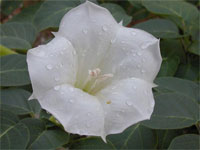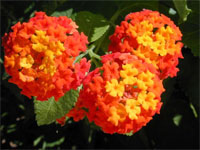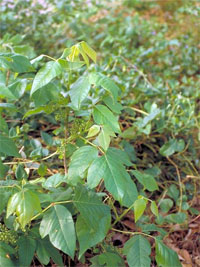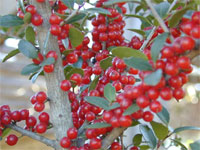Wild About Texas – September, 2008
Poisonous Plants Native to Texas

Jimsonweed, Datura wrightii. Photo by Joe Marcus.

Texas lantana, Lantana urticoides. Photo by Joe Marcus

Poison ivy, Toxicodendron radicans. Photo by Jerry Barrett

Yaupon holly, Ilex vomitoria.
Photo by Joe Marcus
Everything is edible … at least once! Everyone should be aware of the many botanical hazards in the gardens and natural areas of Texas, especially if small children, who naturally put things in their mouths, may be exposed.
There are many factors influencing the level of poisoning one can receive from ingesting a toxic plant. Growing conditions such as climate and soil composition, as well as the age of the plant, quantities and parts of the plant eaten, and other concerns can affect chemical composition and potency of toxic compounds. The overall size, age, and general health of a person also control how that person will tolerate a poisoning.
Generally, bitter-tasting plants should be avoided. And remember, just because an animal can safely consume a particular species doesn’t mean that it will be tolerated by a human’s system. There are no fool-proof ways to pre-determine whether or not a plant is poisonous. It is best to learn about the plants that surround you and impart this information to others. Children must be taught not to put anything that is unfamiliar in their mouths.
Many poisonings in adults result from false identification of wild plants. When in doubt, do not eat it! Other instances arise from experimentation with and overdoses of hallucinogens found in jimsonweed or Texas mountain laurel, both of which have caused fatalities. (Fortunately, mountain laurel seeds have very hard coats and pass through the system, usually causing no harm.) Essentially, hallucinations arise from moderate poisonings, and because of the high stakes involved, such experimentation is highly discouraged. Determining “safe” dosages is extremely difficult due to the factors mentioned above.
In most cases, plant poisonings are not fatal, but may induce extremely unpleasant or acute symptoms. Some compounds may be carcinogenic or have long-term implications. To reduce the risk of accidental exposure, here are a few commonly encountered native plants to be respected. (All parts of all of these plants are considered toxic except where otherwise noted.)
• Jimsonweed, datura – Datura spp.
• Carolina jessamine –
Gelsemium sempervirens
• Yaupon holly – Ilex vomitoria
• Lantana – Lantana urticoides (L. horrida)
• Mistletoe – Phoradendron tomentosum
• Pigeon berry – Rivina humilis
• Texas mountain laurel – Sophora secundiflora
• Poison ivy, poison oak – Toxicodendron radians, T. pubescens
If ingestion of a potentially toxic plant is known or suspected, immediately contact your local poison control center and/or a medical doctor. The following information will be helpful:
• Name of the plant in question (bring a sample if possible)
• Quantity consumed
• Parts of the plant ingested
• Age and weight of the person
• Description of symptoms, if any
For more information about Texas native plants, visit the Wildflower Center’s website at: www.wildflower.org.
About the author: Andrea DeLong-Amaya is the director of horticulture at the Lady Bird Johnson Wildflower Center in Austin.
Bibliography
Hardin, James W., and Jay M. Arena, M.D. 1974. Human Poisoning from Native and Cultivated Plants. Durham, N.C.: Duke University Press.
Tull, Delena. 1987. Edible and Useful Plants of Texas and the Southwest. Austin, TX.: University of Texas Press.
http://www.vth.colostate.edu/poisonous_plants/index.cfm
